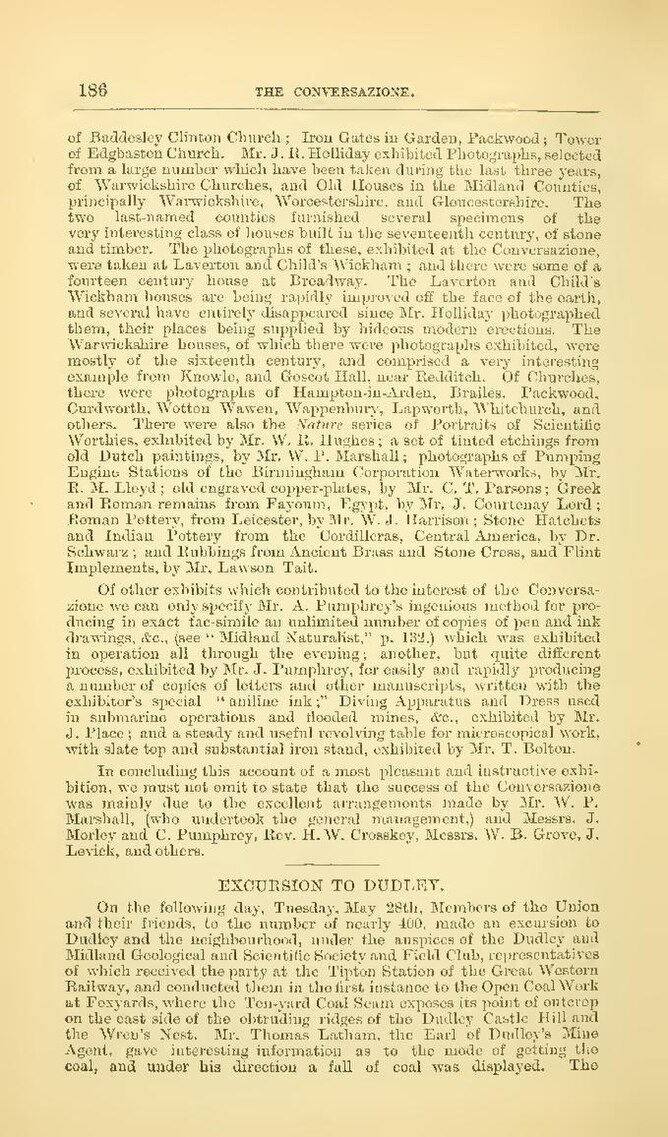of Baddesley Clinton Church; Iron Gates in Garden, Packwood; Tower of Edgbaston Church. Mr. J. R. Holliday exhibited Photographs, selected from a large number which have been taken during the last three years, of Warwickshire Churches, and Old Houses in the Midland Counties, principally Warwickshire, Worcestershire, and Gloucestershire. The two last-named counties furnished several specimens of the very interesting class of houses built in the seventeenth century, of stone and timber. The photographs of these, exhibited at the Conversazione, were taken at Laverton and Child’s Wickham; and there were some of a fourteen century house at Broadway. The Laverton and Child's Wickham houses are being rapidly improved off the face of the earth, and several have entirely disappeared since Mr. Holliday photographed them, their places being supplied by hideous modern erections. The Warwickshire houses, of which there were photographs exhibited, were mostly of the sixteenth century, and comprised a very interesting example from Knowle, and Goscot Hall, near Redditch. Of Churches, there were photographs of Hampton-in-Arden, Brailes, Packwood, Curdworth, Wotton Wawen, Wappenbury, Lapworth, Whitchurch, and others. There were also the Nature series of Portraits of Scientific Worthies, exhibited by Mr. W. R. Hughes; a set of tinted etchings from eld Dutch paintings, by Mr. W. J. Marshall; photographs of Pumping Engine Stations of the Birmingham Corporation Waterworks, by Mr. R. M. Lloyd; old engraved copper-plates, by Mr. C. T. Parsons; Greek and Roman remains from Fayoum, Egypt, by Mr. J. Courtenay Lord; Roman Pottery, from Leicester, by Mr. W. J. Harrison; Stone Hatchets and Indian Pottery from the Cordilleras, Central America, by Dr. Schwarz; and Rubbings from Ancient Brass and Stone Cross, and Flint Implements, by Mr. Lawson Tait.
Of other exhibits which contributed to the interest of the Conversazione we can only specify Mr. A. Pumphrey's ingenious method for producing in exact fac-simile an unlimited number of copies of pen and ink drawings, &c., (see "Midland Naturalist," p. 132.) which was exhibited in operation all through the evening; another, but quite different process, exhibited by Mr. J. Humphrey, fer easily and rapidly producing a number of copies of letters and other manuscripts, written with the exhibitor's special "amiline ink;" Diving Apparatus and Press used in submarine operations and flooded mines, &c., exhibited by Mr. J. Place; and a steady and useful revolving table for microscopical work, with slate top and substantial iron stand, exhibited by Mr. T. Bolton.
in concluding this account of a most pleasant and instructive exhibition, we must not omit to state that the success of the Conversazione was mainly due to the excellent arrangements made by Mr. W. P. Marshall, (who undertook the general management,) and Messrs. J. Morley and C. Pumphrey, Rev. H. W. Crosskey, Messrs. W. B. Grove, J. Levick, and others.
Excursion to Dudley.
On the following day, Tuesday, May 28th, Members of the Union and their friends, to the number of nearly 400, made an excursion to Dudley and the neighbourhood, under the auspices of the Dudley and Midland Geological and Scientific Society and Field Club, representatives of which received the party at the Tipton Station of the Great Western Railway, and conducted them in the first instance to the Open Coal Work at Foxyards, where the Ten-yard Coal Seam exposes its point of outcrop on the east side of the obtruding ridges of the Dudley Castle Hill and the Wren's Nest. Mr. Thomas Latham, the Earl of Dudley's Mine Agent, gave interesting information as to the mode of getting the coal, and under his direction a fall of coal was displayed. The
